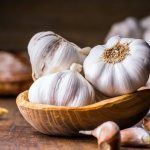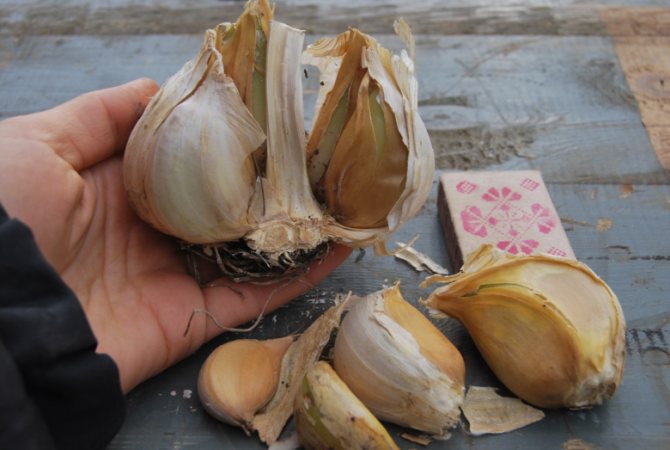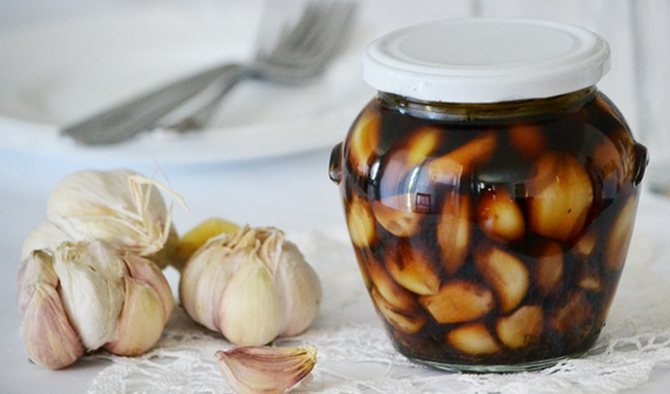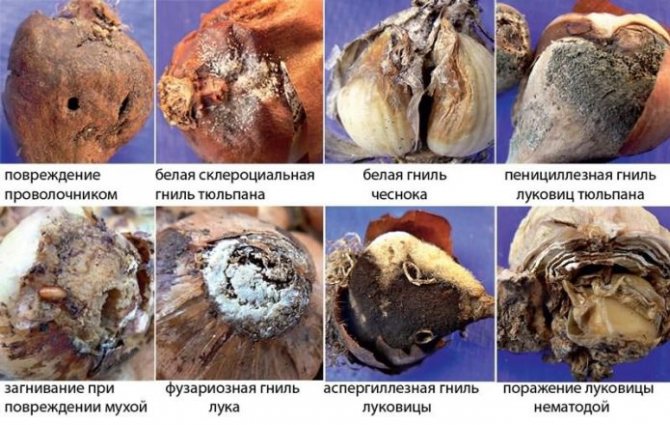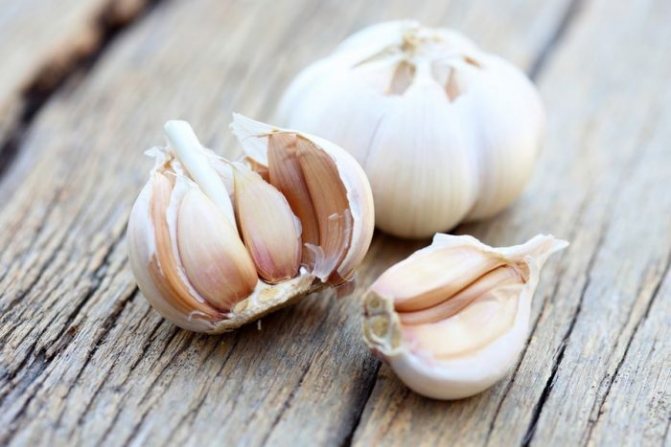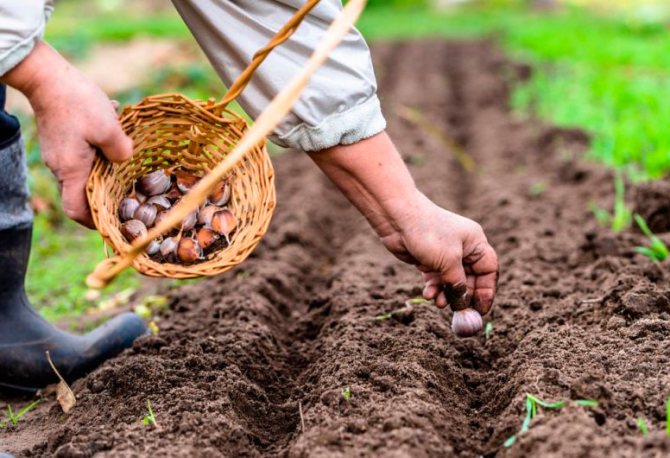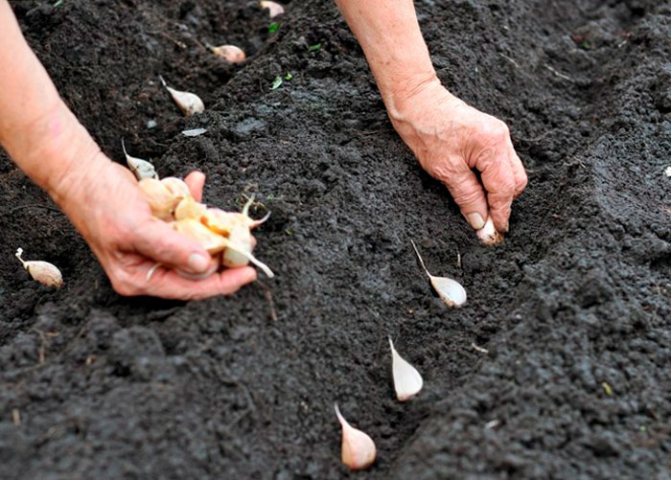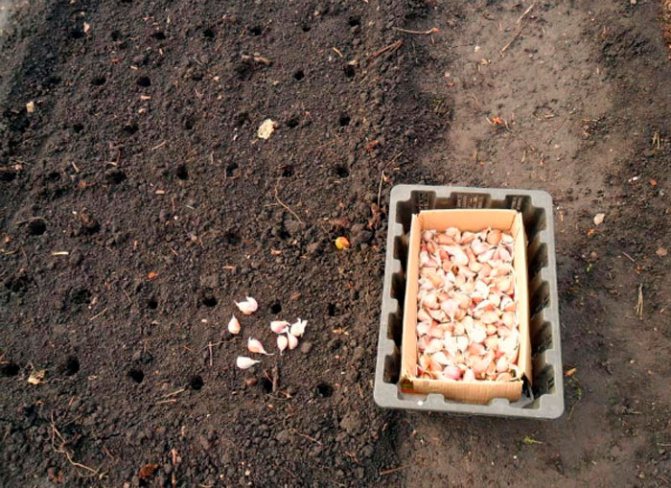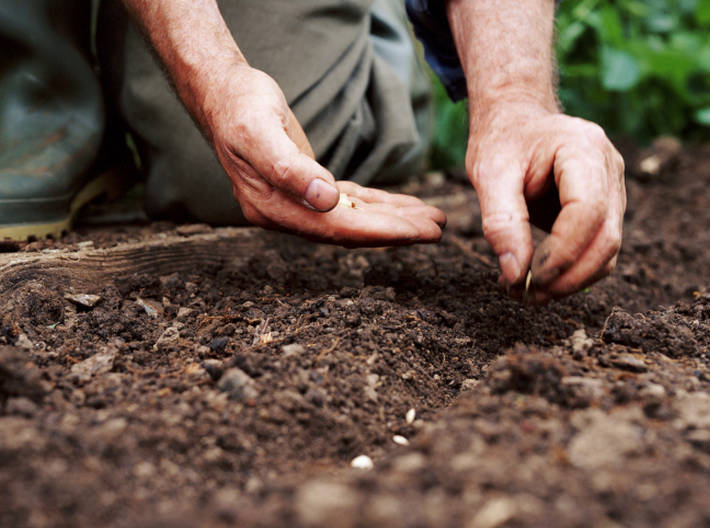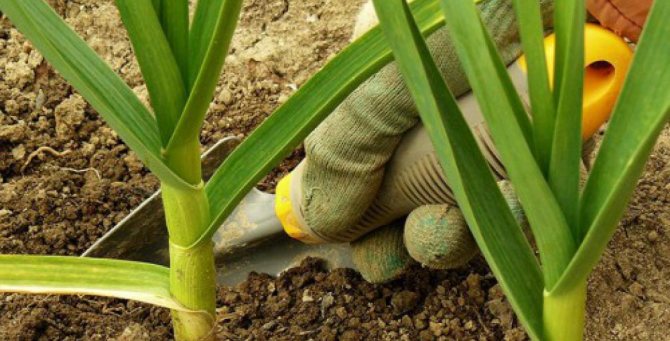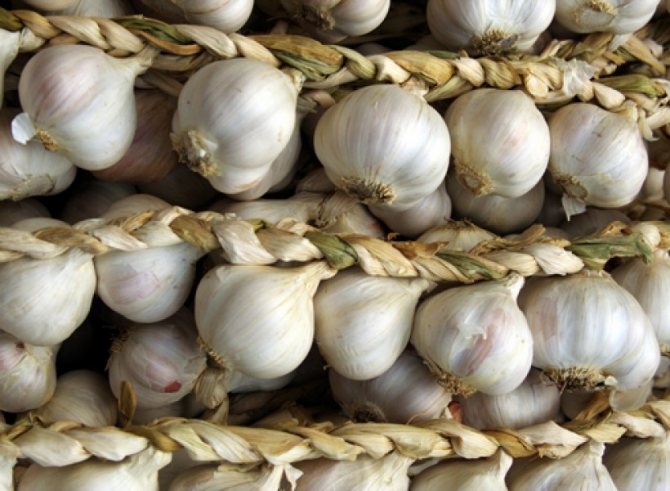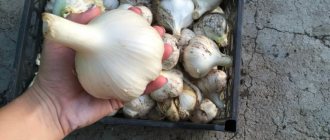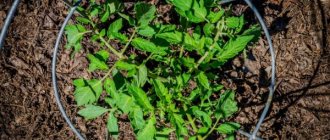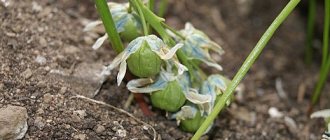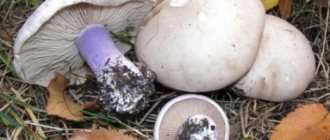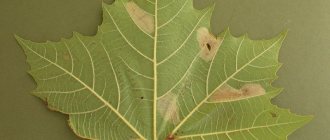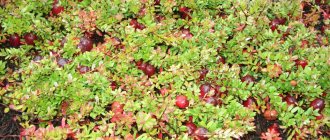Vegetable growing »Garlic
0
2574
Article rating
Garlic is one of the oldest agricultural crops. Central Asia is considered the birthplace of this plant, but it was cultivated in Ancient Egypt, Rome, and India. Today there are many varieties of plants that differ in planting time, shape, taste, yield. Consider the most popular varieties of garlic.
Popular varieties of garlic
History of origin, distribution and interesting facts
In Europe, hybrid varieties of Dutch bred garlic have become widespread; the seed packages indicate: "Garlic Elephant Garlic". And in the translation "Garlic" - and there is "garlic" a plant of the species Allium sativum, i.e. it's just a hybrid Elephant garlic, which summer residents call rocumbole for its size.
In the United States, rocambole ranks among the classification of garlic, which is divided into archery (like Rocambole) and non-archery.
There is nothing in our Wikipedia about rockumball. In the world, we find the following record:
“The sand leek (Allium scorodoprasum), also known as rocambole and Korean pickled-peel garlic, is a Eurasian species of wild onion with a native range extending across much of Europe, Middle East, and Korea. The species should not be confused with rocambole garlic, which is A. sativum var. ophioscorodon. "
which translates something like this:
Sand leek (Allium scorodoprasum), also known as rocumball and Korean pickled garlic rind, is a Eurasian wild onion species with a native range that spreads over most of Europe, the Middle East, and Korea. The species should not be confused with the rocamboli garlic, which is A. sativum var.ophioscorodon.
In the "Great encyclopedia of gardening" Sh.G. Bekseev (St. Petersburg: "Dilya", 1999.), about Luka haircut (Allium scorodopmsum L)., It is said that he has a different name:
“Rockambol, or speed. In the wild, it is ubiquitous in Europe, from Central to North (Denmark, southern Sweden and Finland), as well as in Asia Minor, on the islands of the Aegean Sea. It is widely used in Chinese cooking and for pickling. Hair onions are close to garlic in many ways. It is cultivated in small areas in the western regions of the European part of our country and more widely in Western Europe and China. "
In the Encyclopedic Dictionary of Brockhaus and Efron, in an article about Luke, we find the following description:
“Garlic, chenek (Polish), Hiopu (cargo), skhtur (Armenian) - half leafy stem, flat leaves, bulb contains many small bulbs, which are used for food. Wildly in Central Asia, in the Altai countries. A. Scorodoprasum L. - rockambol there is a difference of the previous one ”.
This vegetable is very interesting! Hybrid onions and garlic Rocumball has many names:
- On the Iberian Peninsula - he spanish bow;
- North Africa knows him by name Egyptian garlic;
- In America, Korea, China - he elephant garlic;
- In some countries - elephant bow or elephant garlic;
- In Russia, an onion or garlic called rocamboll has been known since the 19th century, but gardeners use the name hairstyle bow.
Rocambol is a herbaceous perennial. It has a high dense peduncle up to 120 cm and long leaves (up to 60 cm), the number of which is up to 9. The Spanish bow throws out an arrow with a very beautiful purple flower. Here lies the first surprise of our adventurer: he is sterile. Rocumball does not have nigella seeds like onions, nor bulb seeds inherent in garlic.
What does a rockambol bow look like:
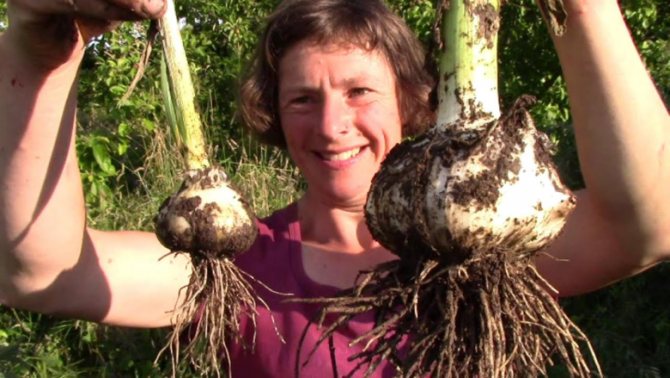
This is the kind of giant you can grow
It will be interesting for you to know:
- The secret of reproduction Rocumbola is hidden underground, where the adult fetus is formed. It is a head of garlic of impressive size: 6-10 cm in diameter and weighing 200-400 g. For comparison: a large fruit of ordinary garlic weighs an average of 120-150 g, and a good bulb - 220-240 g.
- Large representatives of the giant's elephant garlic weigh up to 500-600 g.
- Seed material of Rocumboll - another surprise of culture. The children planted in the soil the next year grow into single-tooth bulbs weighing 40-50 g, that is, in the second year of the growing season, the plant behaves like an onion.
- From the one-toothed bulb in the third year, giant garlic heads with lobules weighing up to 80 g.
- If the summer was cold, then the one-toothed Rocambol simply grows to a large size (up to 100 g), and division into slices occurs in the 4th year. In this way, vegetation cycle Rocumbola is 3-4 years.
- Planting material can be: children, single-tooth bulbs, cloves (cloves).
- Emigrants from Europe brought rockambol to America. Today, Peru produces 35% of the world's rockumbol crop.
- In the USA, in the town of Gilroy, an annual food festival is held, the main ingredient of the dishes is rockambol. Dozens of field kitchens with the best chefs in the states await guests of the holiday.
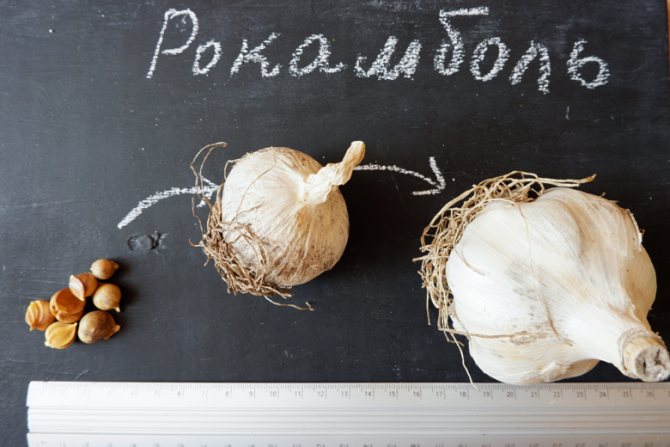

Babies, one-toothed bulb and ripe head
Contraindications
However, in addition to its usefulness, this garlic has a number of side effects:
- With frequent use of Egyptian onions, visual acuity decreases;
- May cause allergic reactions and itchy skin;
- Excessive consumption negatively affects the digestive system;
- It is not recommended to eat this spicy Suvorov onion for people suffering from gastritis or ulcers;
- In rare cases, headaches may occur.
In addition, it is categorically contraindicated to consume elephant garlic:
- pregnant and lactating women;
- people suffering from diseases of the stomach, kidneys and gallbladder;
- with internal bleeding.
What is Rocambol and its beneficial properties
Onions and garlic are species of the same genus - onions. Rocambol onion is their relative, variety. And no matter how we call it, the useful properties of rockambol cannot be taken away. It has a pleasant, unobtrusive taste. Sharing with onions, it is not so bitter. Being related to garlic - it is not so sharp.
- After eating, this vegetable does not leave a specific garlic smell in the mouth, due to which many refuse garlic.
- It will replace garlic in Asian dishes and onions in Russian dishes. He can easily replace onions and garlic in kharcho soup, fried potatoes, goulash, pizza, since he inherited a high iron content, vitamins A and C from onions, and allicin from garlic.
- This "adventurer" will change the idea of the most common recipes. It gives a special flavor to salads, goes well with apples.
- The bulbs can be used as a seasoning, grilled, or pickled.
On a note! Young leaves of rocumball are suitable for use in food: they are similar to the leaves of leeks and are used fresh, pickled or frozen. Rocumball arrows can be fried - their taste is similar to mushrooms, or pickled - we get the taste of capers.
Rocambol is used in folk medicine.
- Having phytoncides, it has antibacterial, antiviral properties, enhances immunity, is a good prophylactic against seasonal colds.
- Onion garlic is used for cardiovascular diseases, it lowers the level of "bad" cholesterol in the blood.
- In moderate doses, it is beneficial for the gastrointestinal tract, relieves toothache and treats stomatitis.
- Being a natural antiseptic, it relieves inflammation, promotes healing of skin wounds.
Harm from onion and garlic can only be obtained with excessive use of it. It can irritate the mucous membranes. Not recommended for gastritis, ulcers, chronic kidney disease.


Young rocumball bulb
Humidity
It is best to grow garlic in well-moisturized soils. Especially a lot of moisture is required during the intensive formation and growth of the root system and the formation of bulbs. With insufficient watering, the leaves begin to turn yellow from the lower tier and gradually die off, which reduces the yield of bulbs. On the other hand, during the ripening period of the bulbs, watering is reduced, which contributes to the formation of dense bulbs. In case of excess moisture during this period, the covering peel quickly cracks, and the teeth become bare, the bulbs are divided into cloves, the yield and quality decrease. Garlic also does not tolerate flooding.
Chemical composition and calorie content
The Rockumball Advantage - taste and nutritional qualities that combine the properties of onion and garlic. It contains vitamins A, FROM, ironlike a bow and allicin - like garlic.
The disadvantage of rockumball short shelf life - 4-6 months.
The chemical composition is presented in the table:
| Vitamins | Contained, on average | Minerals | Contained, on average |
| PP | 0.7 mg | calcium | 181 mg |
| IN 1 | 0.2 mg | magnesium | 25mg |
| AT 2 | 0.11 mg | sodium | 17 mg |
| AT 5 | 0.6 mg | potassium | 401 mg |
| AT 9 | 3 μg | iron | 1.7 mg |
| FROM | 31.2 mg | zinc | 1.16 mg |
| E | 0.08 mg | copper | 299 μg |
| TO | 1.7 mcg | manganese | 1,672 mg |
| Choline | 23.2 mg | selenium | 14.2 mcg |
Nutritional value of rockumbol:
- Calories, kcal: 149
- Protein, g: 6.4
- Fats, g: 0.5
- Carbohydrates, g: 31.0
Varieties and varieties
Gardeners grow many different varieties and hybrids. In the state register of breeding achievements, which are allowed for use, only one cultivar "hair onion" (Allium scorodoprasum L.) has been entered so far, but other cultivars are also used in practice.
- Variety "Pearl"
In the register since 2006, the patent holder is the State Scientific Research Institute of Breeding and Seed Production of VEGETABLE CROPS, according to the characteristics - a spicy variety, orchard culture. Bred specifically for Siberia.
The variety is mid-season, produces an arrow, has a light green leaf with a weak waxy bloom, 45-60 cm long, 3-4 cm wide. The bulb is large, round-flat, the color of the covering scales is white, the flesh is yellowish.
The mass of the onion is about 50 g, in the onion there are 4-6 cloves weighing 12 g each. Under the covering scales, from 3 to 5 children weighing up to 1.5 g are formed.
The taste is spicy, the yield is 1.9 kg / sq. m, the variety is frost-resistant.
It is impossible to find this variety in mass sale. The bulbs of the variety are not half a kilogram, like elephant garlic, which is common in the USA and Europe.
- Hybrid "White elephant" - a product of the selection of Belarusian specialists. Not included in the register of the Republic of Belarus. But it has good qualities: a large onion, up to 150-200g. Does not give flower arrows. Resistant to cold weather as well as fusarium, suitable for regions with short summers.
- Variety "Janissary" - withdrawn in 2020. It has a very large - up to 0.5 kg onion, immunity to viral, fungal diseases. But it does not tolerate cold weather.
The best imported varieties include:
- Red Rocambol - 8-10 large lobules per bulb, grows better than other varieties in high humidity conditions. Large uniform bulbs, strong, spicy taste.
- Ukrainian Rokambol - medium-sized bulbs with 8-9 cloves. Resistant to weather conditions, disease resistant. Has a full flavored taste, spicy aroma. The disadvantage is the short shelf life.
- Garlic Garlic Montana Giant product of Italian selection, distinguished by large teeth. In one head there are on average 5-7 of them. The diameter of the head is 6 cm. The shell is white-pink, easily separated from the pulp. The taste is spicy, pleasant. The aroma is strong, garlic. Great for cooking.
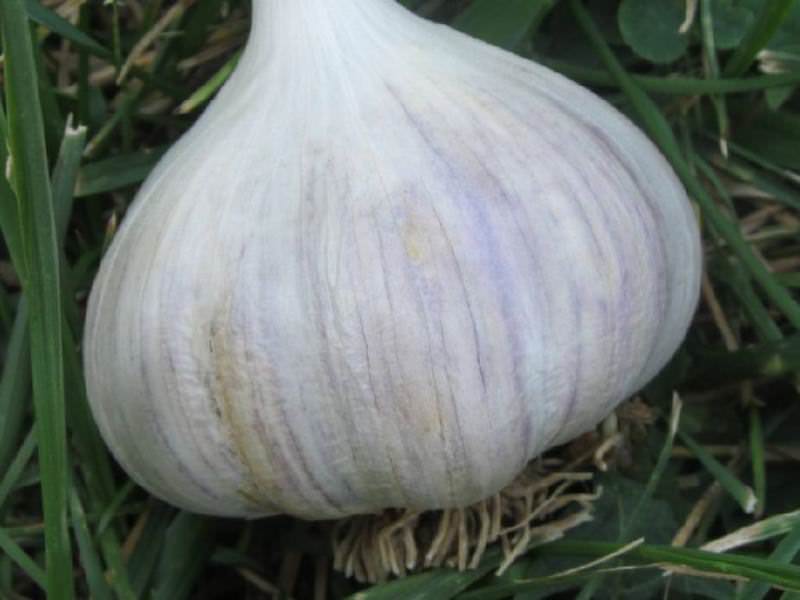

Hybrid variety "Garlic Montana Giant"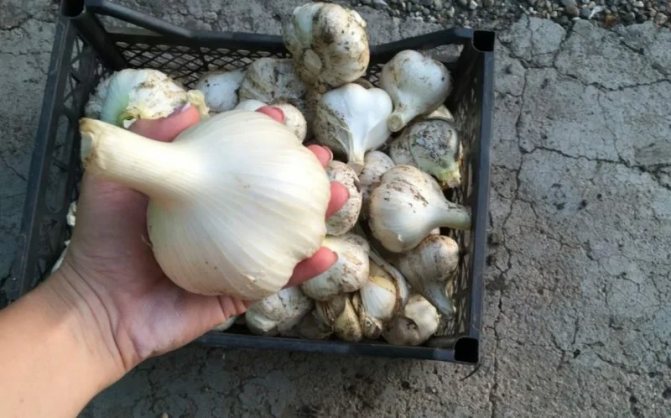

Variety "Pearls"
When buying seed, you need to consult with the manufacturer of the product, find out the features of a particular variety or hybrid
Donets and leaves
The main part of the plant is a modified shortened stem, otherwise the bottom. On it, buds are formed in the axils of the leaves, from which teeth grow. In arrowhead varieties, as a rule, an arrow without leaves grows from the bottom, which is a continuation of the stem.
Leaves are formed at the bottom. In the arrowhead varieties, the leaf width is 1.5–2 cm, and the length is 20–30 cm, and in the non-arrowhead varieties, it is 0.8–1.5 and 15–25 cm, respectively. On average, a plant has 6 to 12 leaves.
Outdoor cultivation
On the Internet, they approach the cultivation of rockambol as to growing garlic, and in agricultural technology they do not even use the word rockambol.
But this is fundamentally wrong. Having made the decision to grow garlic onions, it is important to understand that you are growing leeks, not garlic, or you get leeks, therefore, their agricultural technology is slightly different.
The main differences between growing hairstyle and common garlic:
- onion-garlic is very fond of nitrogen, it can be grown on rotted manure of the first year of application.
- garlic onions are very fond of water in large quantities. Water it more often and abundantly than garlic.


Rocambol in the open field
Like all onions, rockumbol feels great in open ground. The cultivation technology is something between garlic and onions.
With the exception of some hybrids that can tolerate shade, all rockumboli love light, warm areas. When growing, it is important that the soil for planting is loose, the ground is moderately moist, without stagnation of water. Onions do not grow in lowlands.
The best predecessors of rockumball in the garden are considered rapeseed or alfalfa, like green manure. Garlic onions grow well in the garden and vegetable garden after zucchini, cucumbers, cabbage or legumes.
In no case should you plant a plant after onions, garlic or potatoes.
Planting in spring and before winter
Rocumball onions are grown as a spring and as a winter crop.
Larger bulbs are obtained from a plant planted before winter. A good harvest of rockumbol depends on the selection of planting material. So, for podzimny planting, cold-resistant varieties are used, and for spring planting, heat-loving ones.
Optimal planting times
In areas with a temperate climate, it is practiced podzimnaya planting garlic onions (rockambol). Here you need to choose the best time frame. They fall 2-3 weeks earlier than the first frosts (not frosts!). The garlic onions will have plenty of time to take root, but not start sprouting. With the onset of frost, it will go through the vernalization period, and in spring it will be one of the first plants to sprout. Seedlings are very similar to leeks, they are a valuable vitamin product.


Seedlings of rockumball
In spring, onion garlic is planted as early as possible - even before the soil warms up. The plant is very capricious, therefore, planting late in the spring - we get a one-tooth bulb. This does not matter for cooking, but it is not suitable for planting material.
Spring planting giant garlic
Site selection, soil preparation and beds
For planting rockamboll onions, light, warm areas with a southern orientation are chosen.
Before planting rockambol, you should clear the beds of predecessors, grass and weeds, dig up a site 20 cm deep, level the soil.
It will grow on any soil, but if you want to have a good result, you need to choose a site with good drainage, well fertilized with rotted manure (25-40 kg per 1 sq. M.) Soil.
Rocambolle loves fertilized soil, but does not tolerate fresh manure well.
On heavy soils, raised beds should be made.
Agricultural rules for rockambol require soil with neutral acidity within 6-7 pH... If the indicators are higher, the soil is alkalized with dolomite flour or lime.
Selection and preparation of planting material
The preparation of the planting material depends on what choice we have made: to plant the children of a mature bulb, one-toothed bulb or slices of mature bulbs.
On a note! The renewal of the planting material of rockumbol must be carried out every three years - constant cultivation with cloves leads to degeneration. From this we conclude - every year you need plant kids.
Kids... The baby rockambol does not lose germination for about three seasons if stored at a temperature not higher than +8 in a dry room. The baby of the second or third year of storage has better germination than freshly harvested. When preparing for planting, children are scarified without fail. Without doing this procedure, we will get long, unsuccessful shoots, since the baby has a very dense, often double, scales. Scarification - mechanical damage to the scales - is carried out very carefully, cutting off the top of the baby. In view of the laboriousness of such a process, it is possible to scarify the rockumbol children by subjecting them to short-term exposure to contrasting temperatures: alternately lowering the bag with the children into hot and cold water for one second.


Types of planting material: babies, cloves, single-tooth bulbs
On one of the sites, Tatyana Veklenko shared the seedling method of growing rockambol from children. Let's say right away - the process is not for the lazy - so the choice is yours, because the author assures that he achieves one hundred percent germination, and this is important if you take into account the price of planting material.
One-teeth... For planting, whole bulbs are taken, without damage and spots. The material is sorted by caliber for rational distribution over the beds, cleaned of excess husk. Two days before the intended planting, they are soaked in a weak solution of potassium permanganate.
Slices of bulbs... You should select well-ripened, dried onions, without mechanical damage, obvious signs of degeneration and disease. The material from the onion, where at least one slice is rotten or covered with mold, will be unsuitable - we discard such material. When sorting planting material, you should pay attention to the main signs of degeneration: the slices are radically different in size; have grown together; with a double top - we also discard such heads completely.
Pay attention to the bottom of the bulb - it should be free of cracks and damage. Rockumbol bulbs bought in a supermarket may be unsuitable for growing, since to extend their shelf life, their bottoms are treated (burned) in a special way. The separation of the cloves from the bulb is done immediately before planting - in order to avoid drying out of the bottom. We do this carefully to prevent damage to the integumentary scales. Practicing gardeners say that the harvest is no worse from a bare slice, but it is not subject to a long shelf life.
We divide the selected material by caliber and plant slices of different sizes on separate beds, then they will grow more evenly, the harvest will be uniform.
If you are not sure about the planting material, then you need to decontaminate it. Such a procedure will not give a full guarantee, but it will several times reduce the risk of developing diseases and damage by pests of rockambol.
The easiest way to disinfect is slightly pink potassium permanganate solution, having withstood the planting material of rockambol for 15-20 minutes, it has complex disinfecting properties. But others can also be applied:
- saline solution: 2 tablespoons of sodium chloride per 10 liters of water - soak the prepared planting material for a day;
- alkaline ash solution: 0.5 kg of sifted wood ash is poured with three liters of boiling water, we insist for 20 minutes on low heat, we defend until it is completely cooled; We decant the liquid, dilute with 2 parts of cold boiled water and soak the material for 1-2 hours.
- Copper sulfate solution: 2 teaspoons per 1 liter of water - keep the rockambol for 15 minutes - against fungal diseases;
After disinfection, the planting material is not washed, but dried and immediately planted in the ground.
The interest in rockambole is growing - many farmers and private households want to grow it. Prices are also rising, and everyone wants to get the largest caliber planting material inexpensively. Therefore, when choosing, you can bump into sellers who, under the guise of rockambol, sell Suvorov's Onions, Aflatunsky, Gigantsky, some varieties of Anzur's Onions, or even large cloves of ordinary garlic of the porcelain subtype. We do not think that the sellers have any malicious intent. Rather, it is due to their ignorance or ignorance.
Landing the kids of rockumball
Many vegetable growers order seeds from online stores. It is better to do this on the websites of the manufacturers of planting material, so you will save yourself from fakes.
When starting to grow garlic onions, you must understand that this culture is expensive and selected planting material cannot be cheap. When buying material, pay attention to the caliber of the teeth or check with the seller, if not indicated on the store's website. This is important, because teeth will be optimal for spring planting. 35-50 g, and in winter - 20-35 g.
On a note! Less from a clove 20 g when planting in spring, you can get only a larger one-tooth, suitable for further reproduction.
Growing rockambol requires patience from the grower, which is not enough.
For spring planting, the garlic cloves must be kept in a cold (1-2 degrees Celsius) place for 2-3 weeks. This will have a positive effect on proper growth.
Before planting, children and onions must be exposed to sunlight for greening. So they will germinate faster.
Landing scheme
The planting scheme and caring for the plants of the rocambolla garlic depend on what material we use.
- Children... Sowing is carried out on a well-leveled area according to the 10 × 10 cm scheme. For winter sowing, we must mulch with a layer of sawdust or straw more than 3 cm.
- One-teeth... Rocambol is planted in rows with an interval of 30-40 cm and at a distance of 20 cm in a row. Planting depth is three sizes of a bulb.
- Teeth... Onions and garlic are planted in rows with an interval of 30 cm and in a row - 15-20 cm bottom down to a depth of 3-5 cm. To avoid damage to the planting material, you must not press on the cloves. Cover with earth and compost.
Growing garlic
Plant garlic only in fertile areas. He prefers sandy soil with medium acidity. Also, the vegetable needs a lot of light and heat, and it reacts negatively to waterlogging of the soil.
It can be planted alongside other vegetables, berries and flowers. By the way, garlic is an excellent protector against pests and diseases.
Before planting, the cloves need to be prepared. First, select healthy, large, well-shaped cloves. Then prepare the ash infusion. To do this, you will need half a liter of ash and two liters of water. Dilute the ash in water and let the solution brew a little. Soak the cloves in this solution before planting.
Care
Rocambol is not considered a whimsical plant, but with proper cultivation and care, it pleases its owners very much.
To form full-fledged bulbs from podzimny planting, during the growth of green mass in spring and before the formation of bulbs, regular watering, loosening and fertilization is required.
For the spring planting of garlic onions, the soil should be prepared in the fall: it was dug deep, humus, compost and wood ash were introduced. Here is the same scheme: watering - loosening - fertilizing.
Rocumball. Growing features
Watering and feeding
During the growth period, rockumbol, like most vegetable crops, needs constant care. Missing watering affects the yield. On light soils, watering is done twice a week, on heavy soils, you can do it once.
So that the soil does not dry out, it must be mulched.
If the soil under the rocumball is well fertilized with organic fertilizers, then feeding may not be required.
- First feeding... For podzimny garlic we make at the end of winter or early spring, in the snow. We add ammonium nitrate with a dose of 1 tablespoon per 1 square meter. We feed the spring planting garlic with nitrogen fertilizers when shoots appear.
- Second feeding the same for subwinter and spring rockumball. Produced when 3-4 leaves appear. In 10 liters of water, 1 glass of chicken manure or mullein is diluted, mixed with 1 tablespoon of urea.
- Third feeding for garlic onions of both planting dates. 2-3 weeks after the first feeding, we fertilize the soil with a solution of nitrophoska (2 tablespoons per 10 liters of water) at the rate of a bucket of water per square meter.
- The last feeding we do rockumball at the beginning of the formation of onions. To do this, take 1 tablespoon of potassium sulfate and double superphosphate for 10 liters of water and spill the beds at the rate of a bucket of water for 2 square meters.
On a note! We combine all dressing with watering.
Watering is necessary if we want to get healthy bulbs and babies. With sufficient watering, an increase in the mass of the bulbs and the normal formation of cloves are ensured. So that the soil does not dry out and the bulbous rhizomes develop well, we cover the aisles with mulch.
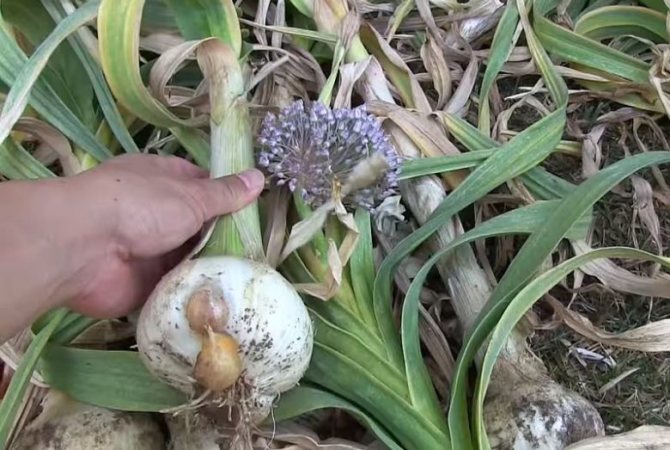

Ripe onion with babies
Weeding, loosening and mulching
With the emergence of the first shoots and before harvesting, care is needed for the beds of rockumbol. The first loosening of podzimny garlic is carried out as soon as the soil dries up. In spring planting garlic - when the first shoots appear. Thoroughly loosen the aisles and the soil between the shoots.
Loosening is done after each watering.
Then twice a week during the growing season we inspect the beds, do weeding to remove all weeds that make their way through the mulch. Only rocumball should grow in a garden bed with garlic onions. Every time we check the plants for diseases or pest infestation. We remove the yellowed prematurely or diseased plant.
We cover the podzimney planting beds with mulch in the fall after planting. The thickness of the mulch is 3 cm or more. The more severe the winter, the thicker: up to 10-15 cm. Mulch is necessary for warming the soil in winter, suppressing weeds and protecting it from drying out. For mulch, sawdust, straw, fallen leaves, synthetic materials are used, which are sold in abundance in seed shops. Summer onions are mulched with straw or synthetic material.


Inflorescences of rockumbol
Delete arrow
Rocumball fires an arrow. It is very long with a beautiful pink inflorescence. There are no seeds in the inflorescence, therefore, to increase the yield, the arrow is removed. We practice removing the arrow as soon as it appears from the tube. To do this, we begin to gently pull the end of the arrow, winding it around the hand.
Interesting! From the arrows, you can make a dish that tastes like fried mushrooms, for this they need to be washed, chopped up to 2-3 cm long and fried in butter.
Some gardeners share the secret that breaking out the peduncle from the rockambol did not get the effect of increasing the bulb itself. This procedure led to an increase in the number of children, which, of course, leads to an increase in the amount of planting material, but increases the time for cleaning the crop. Many babies, breaking off from the mother's bulb, remain in the ground and germinate like a weed plant.
To delete the arrow or not - you decide for yourself.
Disease and pest control
Disease and pest control is a very important point in the care of all cultivated plants. Rocambol is also sick. To fight diseases - you need to know them by sight.
- Rust... Appears on plant leaves in the form of small light brown bubbles.To combat, a sulfur compound is used when spraying or watering.
- White rot... The disease manifests itself with the continuous cultivation of rockumbol in one place. Infectious microbes are found in the soil and on plants, progressive disease can be seen by the growth of cotton fungi with black dots. All affected rockumball is subject to destruction. The soil must be disinfected, after which garlic must not be planted in this place for 15 years.
- Fusarium... The most common onion disease. It appears from the tips of the leaves, which turn yellow, then turn brown, gradually sinking towards the bulb. In very hot conditions, infected plants wilt and the bulbs become watery. Onions that are asymptomatic but infected will rot when stored.
- Thrips and pincers... Insects affecting all bulbous. They stick to the plant and drink the juice, which leads to wilting and death. Leaf wounds will become entry points for other infectious diseases. To combat thrips and mites, it is necessary to dry the mulch in which they develop, use sticky tape or a pheromone trap.
- Onion fly... Lays eggs at the base of the leaves. The developing larvae crawl along the trunk of the plant down to the onion and begin to feed on it. The leaves of the affected plant turn yellow, wither and fall off. In the fight, chemical means of protection are used.


Garlic four-legged mite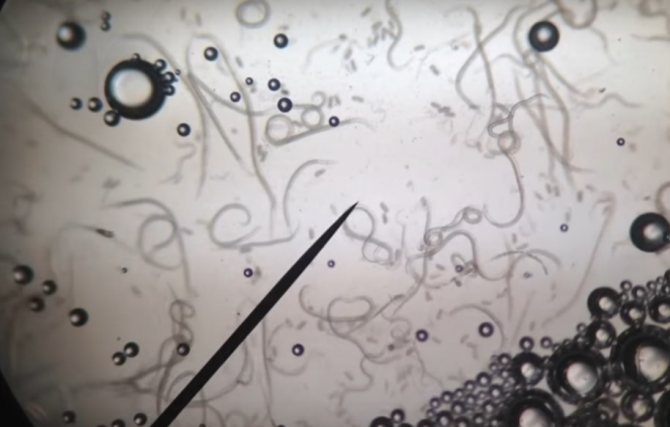

Nematode
- Nematode... Like the fly, the larvae feed on the onion. Rocumball is brought to the same state as white rot or onion fly. Some plants disappear from April to June. Then the whole garden may die. For the fight - chemical methods of protection. For prevention - preliminary preparation of the soil. Crop rotation is ineffective because the nematode affects almost all plants.
Hybrid application
We will not go into the basics of botany. But let's decide for ourselves.
Variety - it is a group of plants selected as a result of selection with the same traits. The seeds of such plants produce offspring with the characteristics of the mother.
Hybrid (F1) - this is the result crosses several varieties to improve color, taste, shape, disease and pest resistance. But their seeds are no longer capable of reproduction.
- Natural rocambol (onion and garlic) is a subspecies of the Onion family. We have already spoken about this.
- Modern rocambol is a hybrid of onions and garlic, onions and natural rocumball, other variations are also possible.
Modern breeding uses a variety of methods to breed hybrids - up to genetic modification. So on the site of the seed shop, I found: "Cyprus rockambol is a hybrid of leeks and garlic with a greater proportion of garlic."
You can distinguish a variety from a hybrid by the inscription on the seed package - there will always be F1.
Description of Rocumball
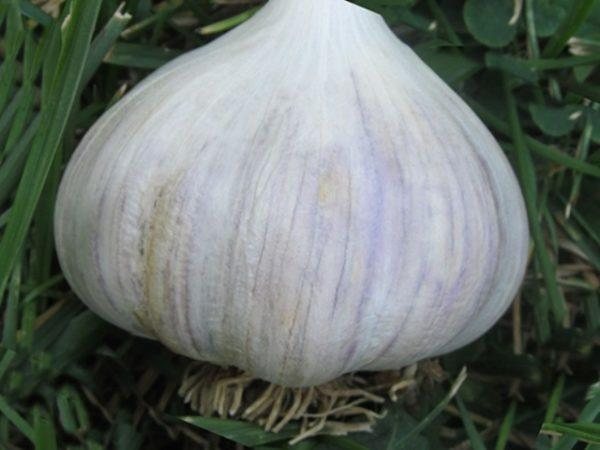

What Rocambol is is a giant hybrid of onions and garlic. It tastes less strong than regular garlic. Doesn't irritate eyes like onions.
It is the most popular and most common hardneck garlic, i.e. "Hard neck". Rocamboli produce large onions that have a deep, rich flavor and are easy to peel, making them a favorite of chefs and highly sought after by the public. However, due to loose flakes, their shelf life is shorter than that of most other varieties and does not exceed 6 months. Most of the bulbs are dehydrated by the end of January. Long-term storage is possible if the bulbs are well grown and well dried prior to storage. The Rocumboll bulb is usually round and blunt at the tip. In most cases, an average of 6-10 cloves per bulb around a lignified stem.
Prefers hot summers and cold winters. Withstands light frosts. Rocambol onions can be planted both in winter and in spring.
Harvesting and storage
Timely harvesting is important when growing rockumball.It depends on the natural zone and time (winter or spring) planting, but you need to focus on the appearance of the plant. Drying of the lower leaves with proper care is the first witness that the onion came at the time of ripeness.
The ripening period begins 2-4 weeks after cutting off the arrows. To be convincing, you can dig one onion and see. It is impossible to overexpose rockambol in the ground - its bulbs grow as long as there are green leaves - there is a possibility of cracking of the outer peel of the heads and the babies fall out, being lost in the ground. With prolonged overexposure in the ground - the head cracks into teeth, such a crop is not subject to long-term storage.
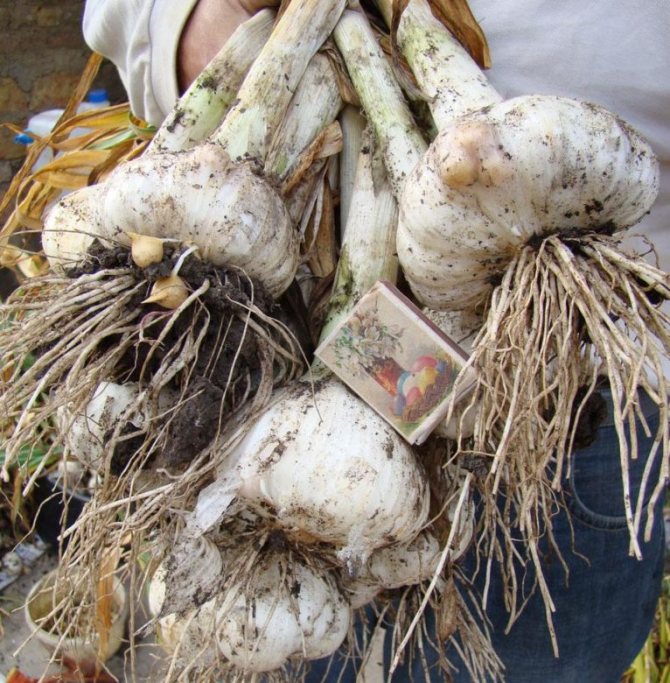

Harvest of Rockumball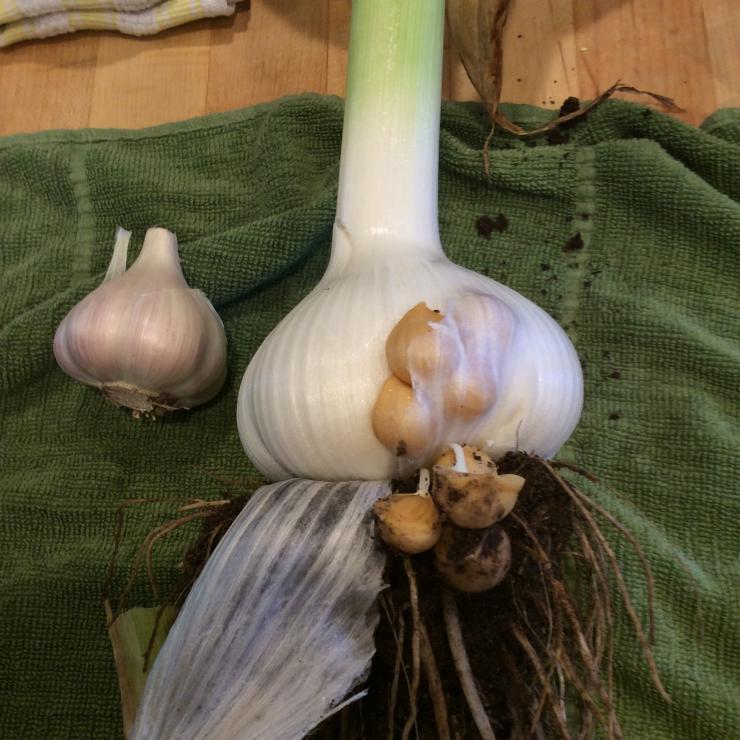

Comparison of bulbs of common garlic and rocumboll
The bulbs are carefully dug out, the clods of earth are shaken off on a sieve, and sieved to separate the detached children. The bulbs can be left to dry in the garden bed, shaded from direct sunlight, but it is better to remove them under a canopy, dry for 2-3 weeks. Then we look through the bulbs and, making sure that they are dry, cut off the roots and stem.
In a rocumball, cut the stems 3-5 cm above the bulbs, tie them, then place them in a dark, well-ventilated place. Thus, you can store Rocambol for 6-12 months with natural air ventilation, humidity no more than 65-70% and a temperature of 2-10 degrees.


Peeled, trimmed, ready-to-store bulbs
Blanks are made from rockambol. The recipes were shared by I. Brizhan from the village of Chelbasskaya, Krasnodar Territory, on one of the sites.
- Divide the rocambol into teeth, pour hot water (50-60 degrees), leave for a day. Then put in jars, pour hot marinade and roll up. Store in a cool place.
- Peel the rocambol, rinse, fill half-liter jars to the brim. Pour boiling water over, add vinegar, sugar, salt. Place in boiling water for 5 minutes to sterilize. Roll up. For 1 can: 1 tablespoon of 9% vinegar, 1 tablespoon of sugar and 1 teaspoon of salt.
- Divide the washed, peeled young heads of rockambol into teeth, put them in a jar, pour the solution (6 tablespoons of salt per 1 liter of water). Close the lid and place in a cool dark place for 30 days. Then drain the water, rinse the teeth with water and pour the marinade (for 2.5 cups of water - 1.5 cups of 9% vinegar, 1 tablespoon of sugar, 1 tablespoon of salt). Close the jar, put in a cool place. In a month, the rockambol is ready. To obtain a beautiful color of the cloves, water can be replaced with a solution of 1 part water and 1.5 parts of red beet juice.
There are many recipes using Rocambolle garlic, it will not be difficult for you to find them.
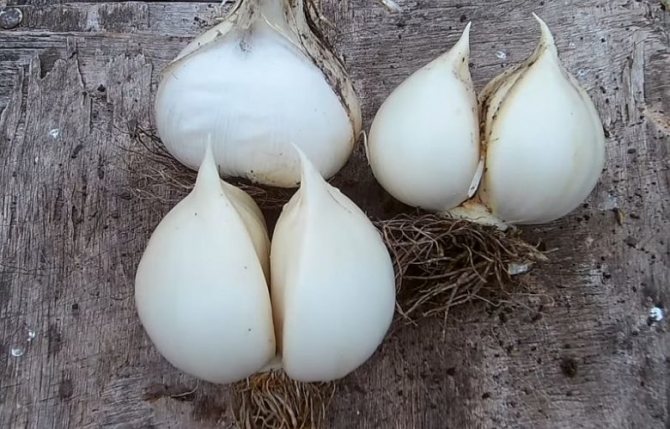

Bulbs of the third year of vegetation
Inflorescence appearance
Some varieties of bulbous vegetables are distinguished by a certain decorative effect. Elastic dense arrows rise above narrow green leaves, growing 60-150 cm.
The flowers of the plant are small, the colors are varied: all shades of lilac or purple. Small buds are collected in a tight lump, protected by a tip shell.
When the arrow reaches its maximum length and gets stronger, the tip opens, forming a globular cluster of small buds. During flowering, the leaves weaken, become lethargic or dry out. The more lush the flowering plant, the more difficult it is for the bulb and foliage to maintain the strength for further growth.
Winter garlic, depending on the variety chosen, blooms from mid-June to early August. Duration of flowering is 30-35 days. Cut off blossoming inflorescences can stand for about a month in a vessel with water, ripening separately from the plant.

